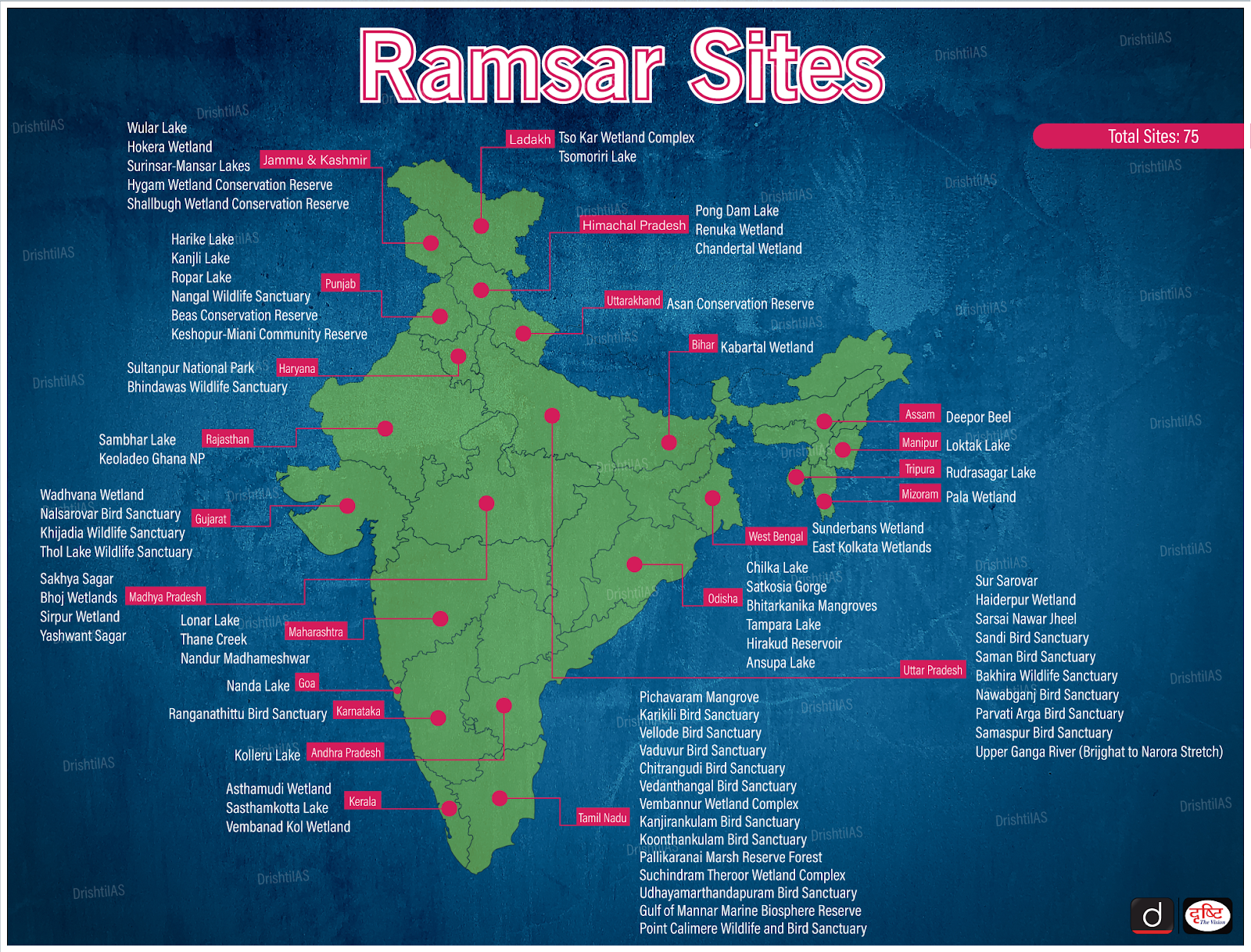Important Facts For Prelims
Amrit Dharohar Capacity Building Scheme
- 25 Jan 2024
- 5 min read
Why in News?
The Central government is spearheading a significant transformation in the realm of wetland tourism with the 'Amrit Dharohar Capacity Building Scheme'.
- This initiative, launched in June 2023, aims to revolutionize tourism practices at ecologically-sensitive wetlands, particularly Ramsar sites like Odisha's Chilika Lake and Haryana's Sultanpur Bird Sanctuary.
What is Amrit Dharohar Capacity Building Scheme?
- About:
- The 'Amrit Dharohar Capacity Building Scheme' is a collaborative effort between the Ministry of Tourism and the Ministry of Environment, Forest, and Climate Change.
- The scheme will be implemented over the next three years (2023 onwards) to encourage optimal use of wetlands, and enhance biodiversity, carbon stock, eco-tourism opportunities and income generation for local communities.
- The primary focus of the Scheme is to strategically transition from high-volume tourism to high-value nature tourism at ecologically-sensitive wetlands.
- Aim:
- The aim is to enhance livelihood opportunities for local communities through harnessing the nature-tourism potential of the Ramsar Sites across the country.
- Implementation:
- The scheme is being implemented in convergence with various Central Government ministries and agencies, State wetland authorities, and a network of formal and informal institutions and individuals, working together for a common cause.
- Pilot Projects and Skill Development:
- Out of 16 identified Ramsar sites, five have been selected for pilot projects under the scheme.
- These pilot sites include Sultanpur National Park (Haryana), Bhitarkanika Mangroves (Odisha), Chilika Lake (Odisha), Sirpur (Madhya Pradesh), and Yashwant Sagar (Madhya Pradesh).
- Training programs for participants are carried under the Alternative Livelihood Programme (ALP) (a 30 hours/15 days training programme) and Paryatan Navik Certificate (boatman certification for tourism).
- Out of 16 identified Ramsar sites, five have been selected for pilot projects under the scheme.
Note
- High-value travellers as those who are likely to spend more, stay longer, and disperse beyond tourist hotspots.
- Nature tourism is based on the natural attractions of an area like birdwatching, photography, stargazing, camping, hiking, hunting, fishing, and visiting parks.
- Nature tourists are experiential tourists who are interested in a diversity of natural and cultural resources.
What is a Ramsar Site?
- A Ramsar site is a wetland designated to be of international importance under an environmental treaty signed in February 1971 at Ramsar, Iran under the auspices of UNESCO.
- Ramsar provides for national action and international cooperation regarding the conservation of wetlands, and wise sustainable use of their resources.
- India has 75 Ramsar sites.
 |
 |
UPSC Civil Services Examination, Previous Year Question (PYQ)
Prelims
Q1. "If rainforests and tropical forests are the lungs of the Earth, then surely wetlands function as its kidneys." Which one of the following functions of wetlands best reflects the above statement? (2022)
(a) The water cycle in wetlands involves surface runoff subsoil percolation and evaporation.
(b) Algae form the nutrient base upon which fish, crustaceans, molluscs, birds, reptiles and mammals thrive.
(c) Wetlands play vital role in maintaining sedimentation balance and soil stabilization.
(d) Aquatic plants absorb heavy metals and excess nutrients.
Ans: (c)
Q2. Consider the following statements: (2019)
- Under Ramsar Convention, it is mandatory on the part of the Government of India to protect and conserve all the wetlands in the territory of India.
- The Wetlands (Conservation and Management) Rules, 2010 were framed by the Government of India based on the recommendations of Ramsar Convention.
- The Wetlands (Conservation and Management) Rules, 2010 also encompass the drainage area or catchment regions of the wetlands as determined by the authority.
Which of the statements given above is/are correct?
(a) 1 and 2 only
(b) 2 and 3 only
(c) 3 only
(d) 1, 2 and 3
Ans: (c)






